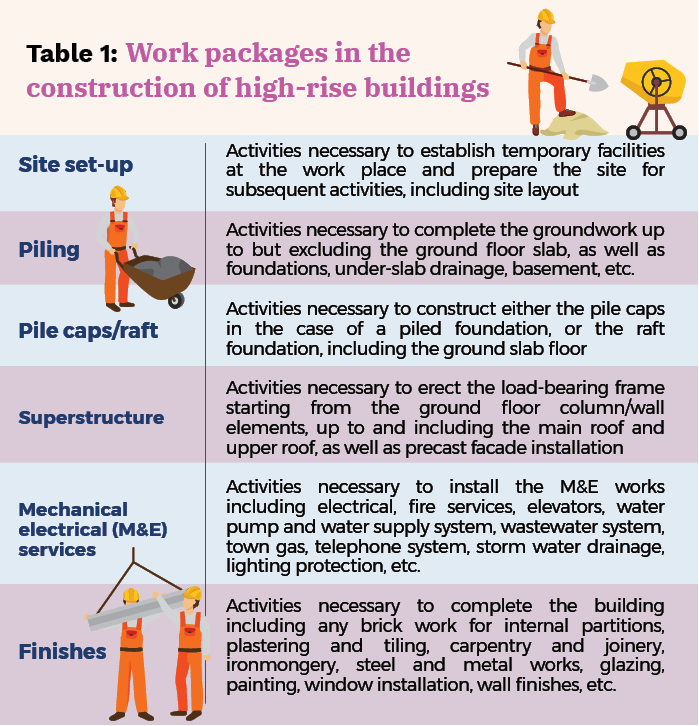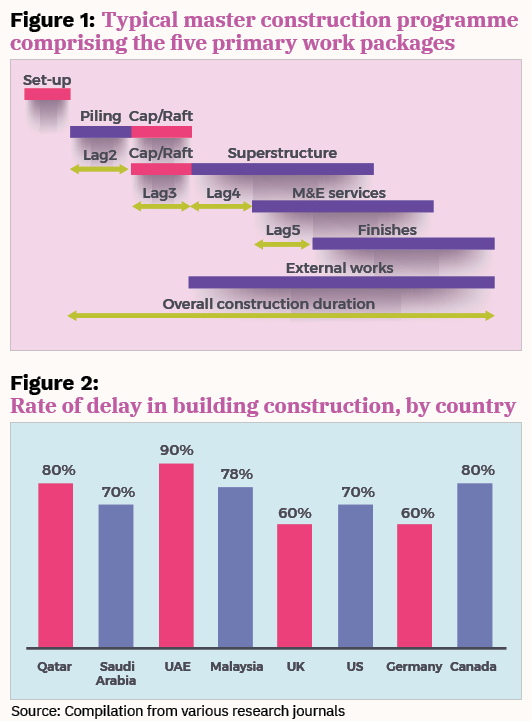
More often than not, the prefabricated construction – or better known as industrialised building system (IBS) in Malaysia – is said to offer benefits concerning cost and time, as compared to the cast in-situ conventional construction.
This is because IBS construction involves off-site manufacturing of structural components, leading to a greater reduction of on-site wet works during the stage of super structure construction that are always considered time-consuming. Also, since the electrical and piping works are already fitted in the precast elements, while plastering works are no longer needed, less time is required in the finishing stage.
As such, the overall construction period for an IBS project is expected to be shorter than a conventional construction project, thereby contributing towards overall cost reduction.
However, in reality, delay (referring to lag time in the construction schedule) has become a norm in Malaysian project developments. Time-saving can hardly be achieved irrespective of the construction system adopted.
This is mainly due to the nature of unpredictable, full-of-uncertainty and endless changing environments in the construction field, coupled with other unexpected incidences originating from human error and management such as limitations set by the local authorities on working hours, the sentiment of the local people with regard to the noise level, traffic congestion caused by the construction activity, etc.
For example, in the case of non-strata/landed developments, where the construction period granted is 24 months to vacant possession (VP) upon signing the sale and purchase agreement (SPA), it is common for developers to set the timeline for actual construction – say not more than 18 months – plus three months for obtaining the Certificate of Completion and Compliance (CCC). The remaining three months will be reserved for contingency in case of hiccups or delay due to improper project management.
Theoretically, such arrangements should be able to prevent any late delivery, as sufficient time is given to contractors to deal with issues related to product quality and labour productivity.
If the contractors work efficiently and follow the planned timeline duly, they may even be able to finish the works ahead of schedule. Unfortunately, delays tend to happen in most cases, and will finally eat into this three-month buffer, leading to no time-saving for the project.
Under these circumstances, it is unlikely that a contractor will counter- propose a shorter construction period than the one stated in the contract; and hence, the supposed cost-saving generated from the reduction of construction period does not happen.
High-rise construction even more complicated
The situation is even more challenging when it comes to strata/high-rise developments. Though a longer construction period – 36 months – is granted, time-saving can hardly be realised as well; given that the design of a high-rise building is more complicated, involving complex engineering systems like plumbing, ventilation, power supply, sewerage, drainage, fire extinguishing systems, automation and dispatching systems, electrical equipment and services, etc.
Besides, extensive foundation works are required to ensure buildings’ strength – especially for buildings that exceed 30 floors and come with podiums or basements – which could easily take up to one year.
In this sense, developers will normally apply for the extension of time (EOT) before the project is launched, or even prior to the signing of SPA with purchasers.
By extending the period of VP to 48 months or longer, not only the delivery of good quality products is ensured, but developers are also put in a comfortable position when going through the process of applying for and delivering strata titles.
Again, the developers will set the timeline and reserve a several-month-buffer for contingency. Again, no contractors would counter-propose a shorter construction period as the reserved buffer will eventually be consumed due to the complexity of high-rise constructions.
Some may argue that the delays in construction projects are mainly due to the inefficiency of the conventional construction system that is being practised widely in our construction field; and the adoption of a more advanced construction technology like IBS can help speed up the construction process.
However, one should realise that, in the case of a high-rise development, time-saving is not dependent solely on construction technology, but rather, on initial planning and the subsequent re-scheduling.
To further elaborate this point, consider the seven common work packages in a high-rise construction as shown in Table 1. The duration of construction is the time span from the beginning of the foundation to the completion and handover of the building to the developer.
A common duration for each of these packages is established by the developer, while the contractor and project manager will ensure the completion of each of these phases within the time frame through the control of variables in the construction works.
However, since these work packages are inter-related to each other, any delay in the preceding package can have a chain-effect on the following package.
For instance, lag time 2 in Figure 1 is affected by the piling duration and type of foundations, while the durations of cap/raft and superstructure are the critical variables in determining lag time 3.
The time lag of different work packages are mainly due to project characteristics like soil condition, complexity level of the design, construction requirements, client requirements, project milestones, and project location.
Besides, one should bear in mind that material hoisting is critical in high-rise developments. As the building “grows”, the transportation time increases and, hence, extends the duration for the crane-related activities.
Owing to the heavy precast elements and the limitation of hoisting machinery capacity, a full IBS project tends to be limited up to a 23-storey height in actual practice. A conventional or hybrid construction system (the application of a reusable formwork system and a certain degree of precast components, with an IBS score of around 50-65), on the other hand, is preferable for a project with higher-storey buildings.
In other words, IBS alone, which is mainly applied during the stage of superstructure construction, can hardly have any significant impact on time-saving.
Formwork system not cause of delay
Most importantly, one should not perceive the widespread use of monolithic reinforced concrete structures as an inefficient construction system, and further blame it for the delays in construction. This is because, the role of formwork systems in leading construction workflows – linking not only the choice of formwork system to logistics planning, inventory dynamics, crane schedules, labour and material deliveries, and safety procedures – also contributes towards higher on-site construction efficiency.
The core objective in a high-rise development is to ensure the completion of the structural frames, so as to generate floor areas for the execution of finishing works, building services installation and internal fitting out. In this sense, a balanced floor construction cycle is critical for the construction of frame structures.
Similarly, when using the reinforced concrete frame, decision on construction work flow is based on the principles of optimising the use of formwork.
The floor area is usually sub-divided into zones in order to enable resources rotating horizontally between zones at the same floor level or moving upward to the upper floor in the next cycle, in order to yield a high number of reuses.

As such, the preparation of the floor construction cycle is rather a resources allocation exercise that sets the pace for other downstream architectural and M&E works.
All in all, a delay in a high-rise construction is complex in nature. It can be caused by more than one party, or by none of the principal parties. It can also be due to multiple delays that occur concurrently, or the accumulated effect of the delays in the individual activities.
The fact is, delays in construction are unavoidable phenomena that could happen in both developed and developing countries. As shown in Figure 2, the rate of delay in building construction projects varies from country to country, irrespective of the level of construction technology. Noteworthily, in Malaysia, between 2014 and July 2019, 523 out of 678 applications of EOT were granted.
On a yearly basis, this worked out to approvals as high as a 70% range, with the highest approval rate of 87% in 2014. Most importantly, projects that applied for EOT included both the IBS and conventional/hybrid constructions.
This should highlight the fact that the efficiency of high-rise constructions, to a large extent, depends on the quality of work flow arrangement and tight schedule control, which are then greatly affected by many other managerial and organisational factors that can hardly be generalised.
Construction technologies like IBS, instead, play a less dominant role in the overall project efficiency. As such, it is unlikely to generate any time-saving, and thus, cost-saving in the context of Malaysian project developments.
Dr Foo Chee Hung is MKH Bhd’s manager of product research and development
This story first appeared in the EdgeProp.my E-weekly on Oct 1, 2021. You can access back issues here.
Get the latest news @ www.EdgeProp.my
Subscribe to our Telegram channel for the latest stories and updates





